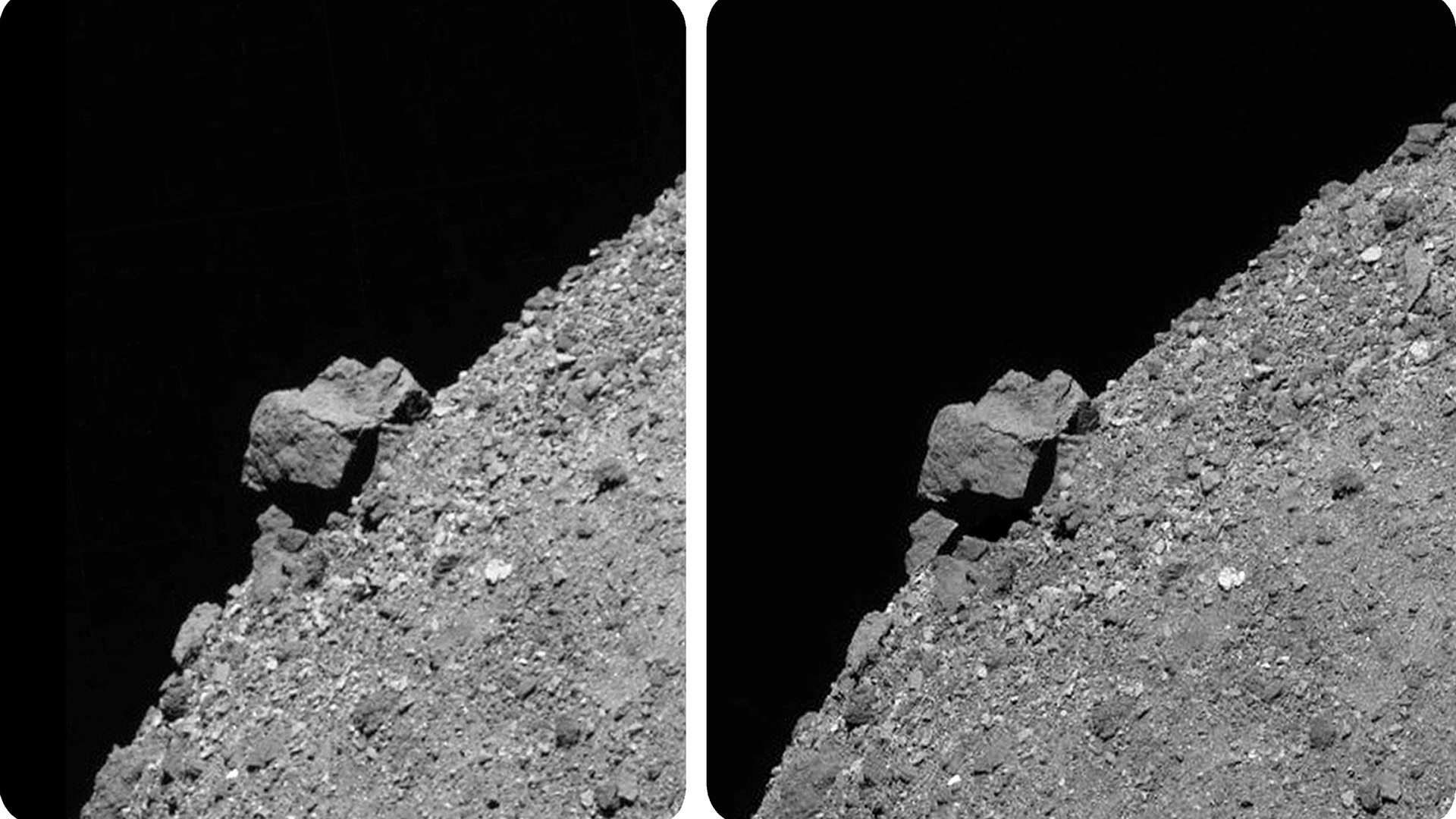Queen's Brian May talks to Space.com about his role in NASA's OSIRIS-REx mission and new book on asteroid Bennu (video)
Best known as a member of the legendary rock band Queen, Brian May might as well be the world's most famous citizen scientist.
Famed Queen guitarist and citizen astronomer Brian May collaborated with NASA's asteroid mission OSIRIS-REx, helping scientists find a suitable landing spot on the space rock that turned out to be completely different from what they had expected and designed their mission for.
May, who famously completed his PhD in astronomy in 2007 after a more than 30-year hiatus enforced by Queen's rise to fame in the early 1970s, sat down with Space.com to discuss his collaboration with the groundbreaking mission, NASA's first attempt to collect a piece of space rock and deliver it to Earth.
The collaboration with NASA started as a space enthusiast's pastime, but quickly turned serious when the team discovered that the 1,722-feet-wide (525 meters) asteroid Bennu, the target of the OSIRIS-REx mission, was completely devoid of suitable landing sites.
As it turns out, May's expertise is in creating 3D-images from single camera shots taken from various angles and processing those to recreate vivid lifelike views. The 3D images of Bennu May created helped the team gauge the nature of the space rock's treacherous surface and ultimately find a crater that not only seemed to contain scientifically promising material, but also looked boulder-free enough to allow OSIRIS-REx, after some serious software updates, to attempt the landing.
OSIRIS-REx's journey is now told in a new book that comes packed with Brian May's images and features a 3D eye-piece designed by the music legend himself. "Bennu: 3-D Anatomy of an Asteroid", authored by May and OSIRIS-REx principal investigator Dante Lauretta, is available in the U.S. from University of Arizona Press and in the U.K. from London Stereoscopic Company.
Here is what the rock star had to say about his time on the team behind the ground-breaking mission.
Related: Queen legend Brian May helped NASA ace its asteroid-sampling mission, new book reveals
Breaking space news, the latest updates on rocket launches, skywatching events and more!

Bennu 3-D: Anatomy of an Asteroid
The first-ever atlas of an asteroid
Bennu 3-D: Anatomy of an Asteroid tells the story of NASA's OSIRIS-REx mission, which explored the hazardous near-Earth asteroid Bennu between 2018 and 2021. The book, written by the mission's principal investigator Dante Lauretta and legendary Queen guitarist and part-time astronomer Brian May is the first atlas of a space rock and comes packed with stunning 3D images created by May himself.
Space.com: Let me start at the beginning. You and the OSIRIS-REx mission, how did the two of you get together? What's the story?
Brian May: Quite informally, really. I am on the outside of NASA, nobody pays me, but I love it. And me and my collaborator Claudia Manzoni generally go around the internet to look for images that we can make into stereos [pairs of images that can be viewed with a special eye-piece to recreate a realistic three-dimensional view]. The data is there from all these different missions from NASA, ESA [the European Space Agency] from JAXA [the Japan Aerospace Exploration Agency]. There is enough data there to find viewpoints in order to make the stereo images, which we crave, we just love making stereo images.
And of course, then you have to use a viewer to appreciate them in 3D. And I am the creator of the London Stereoscopic Company and we now make stereo viewers.
The OSIRIS-REx mission was NASA's first attempt to collect a sample from an asteroid. The mission launched in September 2016 and reached its destination, the near-Earth asteroid Bennu, in December 2018. The probe then spent two and a half years studying Bennu from its orbit. The data revealed that the 1,722-feet-wide space rock, the most dangerous known asteroid in the solar system, looks completely different from what the scientists had expected. A suitable enough landing site was eventually identified and the spacecraft successfully collected a sample in October 2020. However, the team later revealed that Bennu surprised them during the touchdown once again, nearly swallowing the spacecraft like a swamp.
So what happened with me and Dante [Lauretta, the OSIRIS-REx principal investigator], is that I sent him just off the cuff a couple of [OSIRIS-REx] images which I'd made into 3D. And he was amazed. He said 'I have never seen it like this, this is such a great tool and this might be able to help us find the landing site that we need in order to get that sample safely.'
So we started to interact, we started to trade emails and pictures and we have become very good friends during the passage of time. But it was a lot of work, because when it became serious, we were not just making pretty pictures, we were supplying them with images that they can view and make that crucial decision — is this a flat enough site to land our spacecraft? Would it be safe? Would we get the sample back to Earth? So that's what I became engaged in doing. It was a lot of work but very happy work.


Known worldwide as a founding member and guitarist of Queen, one of the greatest rock bands in history, Brian May is also a life-long astronomy enthusiast. In fact, May pursued astronomy as a career before Queen propelled him to another kind of stardom. May abandoned his PhD studies at Imperial College London in 1974 but returned over 30 years later to complete his thesis on the properties of the Zodiacal Dust, the interplanetary dust dispersed between the planets of the solar system. May frequently combines his passion for astronomy with that for stereoscopic imaging and has previously created 3D views from photographs provided by a range of high-profile space missions including NASA's New Horizons and ESA's Rosetta.
Space.com: Is there any particular reason why you were interested in this mission?
Brian May: I am interested in them all. I was incredibly lucky to be involved in the New Horizons mission with Alan Stern [New Horizons principal investigator] who also took me under his wing and I was able to help secure 3D pictures of Pluto. I think I was able to bring the universe's first 3D picture of Pluto to light and then they went on to photograph an object in the Kuiper Belt. The Rosetta mission, also. We made some lovely stereo images of Comet 67P, maybe there is a book there too.
I think the difference is that Dante wanted to involve me and involve us at an early stage so we could actually contribute to the conduct of a mission. That's the crucial difference.
Space.com: I understand that you were actually called upon to help the team solve a major issue that they had, to find a suitable landing spot on the surface of an asteroid that looked totally different from what they had expected. Do you remember what the atmosphere was like among the scientists during this challenging time?
Brian May: I think it was suddenly becoming much more difficult than they expected because Bennu wasn't a solid object with flat places. It was a completely randomly accrued object, it's a rubble pile and there are no places that are safe to land on. There are all sorts of different sizes of pebbles. And it was very difficult to assess what the landing would actually be like if you can't be there and see it with your own eyes.
That's where this comes in handy [May holds up the 3D viewer], because once you have a stereo image of that particular potential landing site, you can really make that instinctive judgment as to whether things are going to work out. You see that there is this boulder, how much slope there is, how dangerous it is to get on and to get off and that's where we were able to get into it.
At one point, Dante said 'all my guys have to see this. I have seen this and this has changed my opinion, I want all my team to see this." So I sent them a box of these [3D viewers] and they sat around the table and made those decisions, looking at Bennu as if they were there.

Asteroid Bennu is a potentially hazardous near-Earth space rock that has a nearly 1 in 1,800 chance of colliding with Earth in the next 300 years. Bennu is a carbon-rich asteroid that likely contains organic compounds as old as the solar system itself. NASA's OSIRIS-REx mission will deliver about 9 ounces (250 grams) of dust and gravel from Bennu to Earth this September, and scientists hope that these fragments will help shed some light on the origins of life on our planet.
Space.com: Can you explain to us how you create these stereo images?
Brian May: Basically, to make a stereo image, you need two different viewpoints, just as in real life, when I look at you, my left eye has a viewpoint and my right eye has a viewpoint that is slightly different. And that's the whole thing really. And what you have to do in making the stereo image is to reproduce that effect, so I have to take a picture for my left eye, I have to take a picture for my right eye and then I put it into a viewer so that my right eye only sees the right image and my left eye only sees the left image and then the effect is reproduced, so I see this crater as if I were about a mile away from Bennu. Byt my eyes, in this case, would be about a mile apart.
Space.com: How did the idea for the book come about?
Brian May: We made so many images and it was a labor of love. But it was also really rushed and I remember saying to Dante 'we have such an amazing collection of images,' not just of the surface but also of the whole planet, which is something really attractive, so we started thinking of a book and we quickly realized that this was the world's first opportunity to make a real atlas of an asteroid. So that's what we attempted to do and the fact that it has stereo images as well I think makes it something very unique and special.

Space.com: Who is the book aimed at, who is the target audience?
Brian May: The book is really aimed at anyone who has an interest in this kind of a subject, anyone who has an interest in what they see when they look up at the night sky. It's not just for scientists. There is a whole world of scientific information in there for anyone who wants it. But if you read it as a story, you should be able to understand it without prior knowledge.
Space.com: Do you have any further plans to cooperate with the OSIRIS-REx mission in the future or any other plans in the astronomy domain?
Brian May: Well, we take what we can get. I would love to go on cooperating with Dante. Dante is now handing over the OSIRIS-REx mission to [a new principal investigator] who will take it to the next subject, which is Apophis [a near-earth asteroid once considered a high risk for Earth], and I would love to have some stereo data from Apophis to work with and make the world's first stereo image of that object.

Tereza is a London-based science and technology journalist, aspiring fiction writer and amateur gymnast. She worked as a reporter at the Engineering and Technology magazine, freelanced for a range of publications including Live Science, Space.com, Professional Engineering, Via Satellite and Space News and served as a maternity cover science editor at the European Space Agency.
